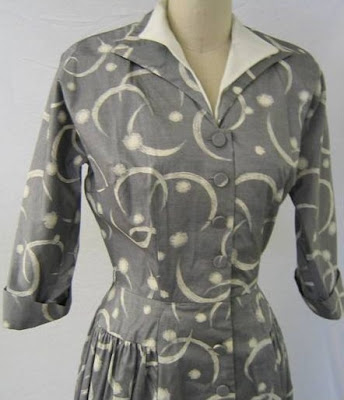 A 1950's day dress by Anjac of Los Angeles is a perfect example of a mid-decade look for adult women. The wing collar is doubled, with a white top collar to frame the face. Classic 3/4 length sleeves have turned back cuffs. The center front closure is dotted with self covered buttons from the "V" neckline to hem.
A 1950's day dress by Anjac of Los Angeles is a perfect example of a mid-decade look for adult women. The wing collar is doubled, with a white top collar to frame the face. Classic 3/4 length sleeves have turned back cuffs. The center front closure is dotted with self covered buttons from the "V" neckline to hem. A slender body silhouette is achieved by having the fitted torso with dropped waistline. This is a silhouette similar to what we see in Givenchy's designs for Audrey Hepburn ("Love in the Afternoon" and "Funny Face", 1957). By lowering a gathered skirt to the hip bone, the waistline doesn't look bulky and full.
A slender body silhouette is achieved by having the fitted torso with dropped waistline. This is a silhouette similar to what we see in Givenchy's designs for Audrey Hepburn ("Love in the Afternoon" and "Funny Face", 1957). By lowering a gathered skirt to the hip bone, the waistline doesn't look bulky and full. The unique fabric pattern is screen printed in white on what seems to be an acetate textile with some shine in soft gray. The fabric texture enhances the dress design, creating emphasis for the skirt folds.
The dress's label is designed to promote California fashion. This marketing technique was popular among companies in the region who hoped to see their products displayed in "California boutiques" at department stores throughout the US.
 The dress label reads:
The dress label reads: Anjac fashions
Made in California
Styled by Jack Needleman
ANJAC story
The Anjac label was designed in Los Angeles for over 30 years. The company was founded by Jack Needleman, who named his new apparel company by combining his name with his wife Annette’s. Needleman had moved to Los Angeles with his wife in 1943 from New York City. In New York he worked in the apparel industry as a jobber. Although Anjac was begun to produce dresses, his business focus would later center on more profitable real estate transactions in the Garment District. By the 1960’s this was to become the force of his business.
Anjac designer, Ilse Metchek, joined the company in 1967. She arrived from Catalina, having worked there designing sportswear. At Anjac her profitable styles financed Needleman’s property expansions in the garment district where he would build an empire that exists today and includes many important historical buildings in the area. He would pass away in 1999, the properties now managed by his family.
Needleman maintained the Anjac label until 1984, when he sold it to Metchek. Under her leadership the company was renamed “Ilse M. Inc”. Metchek designed for her label until 1990 when she gave it up to take a position as president at White Stag. Today Ilse Metchek is president of the California Fashion Association in Los Angeles, which she formed in 1994 to promote unity and compliance within the local apparel industry.
REFERENCES
Fit to a T: from modeling to management, Ilse Metchek taps into her decades in the apparel business to guide the California Fash, by Maya Meinert: Los Angeles Business Journal, March 23, 2009, http://www.entrepreneur.com/tradejournals/article/197105816_1.html
Jack Needleman, OBIT, by Myrna Oliver: Los Angeles Times: May 4, 1999, http://articles.latimes.com/1999/may/04/news/mn-33753
Orpheum Owner Steve Needleman Is Bringing Life Back to Broadway, by Jason Mandell: LA Downtown News: Sept. 24, 2004, http://www.ladowntownnews.com/articles/2004/09/27/news/news03.txt


